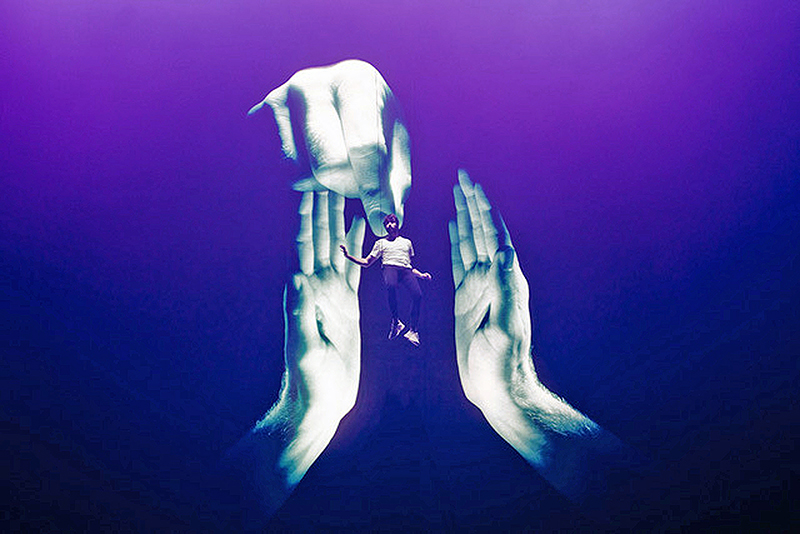
In the middle of performing “Burn The House Down” in their streamed concert show, AJR’s lead singer Jack Met climbs a wooden A-frame ladder 16 feet to the top. He stands on the top platform in a way that every stagehand knows OSHA forbids, but it’s all right — we can see the wires that extend from hooks on either side of his body. Jack won’t fall, we think, as we watch him tell us that it’s time to “get out of our comfort zone.”
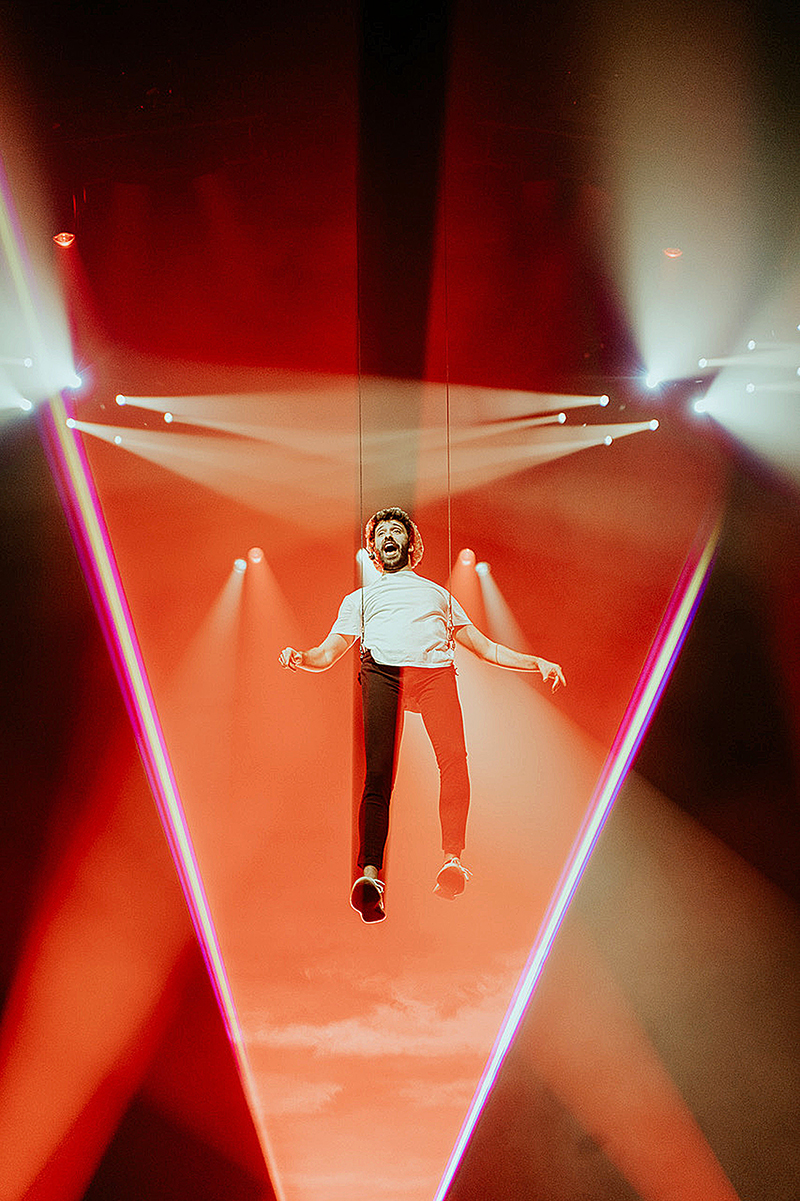
Then Jack hops off the top of the ladder, just as a bright red ribbon of light extends through the air from a laser behind him. The light forms a translucent bridge, and Jack strolls along it in midair as he continues to sing, following it even as it changes trajectory beneath his feet.
We know exactly what all the tricks are, but the illusion still packs a punch. This and a dozen other perfectly executed gags made AJR’s “One Spectacular Night” a concert triumph, especially considering the number of people involved in making them all happen — in the middle of the pandemic of the century.
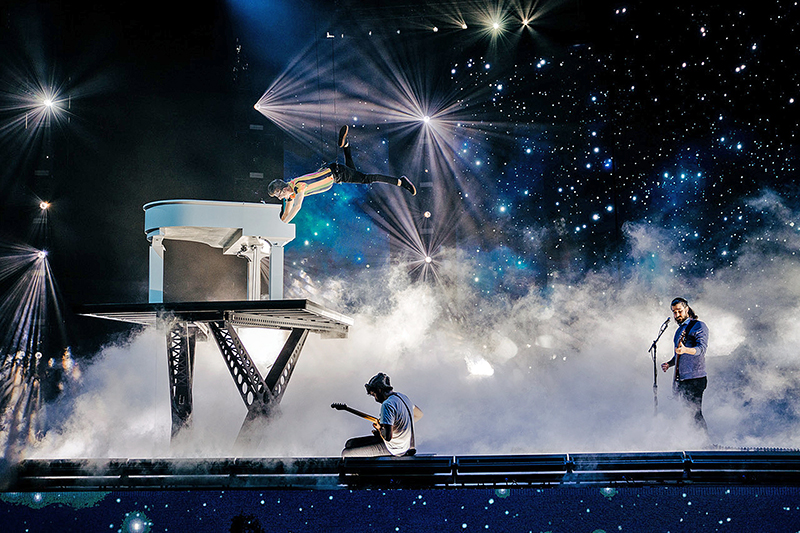
The Origin Story
With their 2020 tour schedule cancelled, the three lead members of AJR — Adam, Jack, and Ryan Met, brothers with a 15-year performance history — found themselves with massive amounts of creativity to burn and no immediate outlet to burn it. They came up with the idea of a single night’s 90-minute performance with all of the wonder of an arena show, but with a ticketed audience watching from their homes or offices.
The band approached Mitchell Schellenger, principal designer at Station Six Productions and the designer of AJR’s 2019 touring show. “I really let them take the reins right out of the gate,” said Schellenger. “They’re always interacting with each other. I would take their ideas and translate them into what they could actually do. We were able to achieve most of them.”
It’s part of the show that the audience sees how some of the gags take place, but in twist after twist, the illusions go one step beyond what viewers expect — in sort of a rock-show-meets-Penn & Teller style. “Because we wanted to do all of these gags for real (not green screen, XR, visual effects, etc.), we wanted to embrace the technology required to make it happen,” said Schellenger. “We knew it would still have a wow factor on camera, but we liked the idea of giving the audience a glimpse behind the curtain — something we wouldn’t necessarily do on a live show in person.”
Once they had a solid concept of the creative aspects, Schellenger and his team approached live event staging company Tait to see what elements they could obtain from them. “We wanted to almost go shopping at Tait and use some of the tech that had already been built,” he said. “We pulled bits and pieces of Tait technology in order to achieve the elements we were looking for.”
Their shopping spree yielded a full-size and a half-size LED wall made from 360 ROE Visual CB5 LED tiles, with two disguise d3 gx-C servers. These gave Schellenger and his team the ability to create responsive, real-time graphics, like a wall of notebook paper that crinkled as Jack ran his fingers over it. A custom three-tiered stage provided levels, a mirror floor, and plenty of room for the brothers to move, and an integrated treadmill and scissor lift created some of the show’s most impressive effects.
Tait also supplied two performer flying systems, a tracking video trolley system for the overhead rig, which also was equipped with four Pyrotek LSG low-lying fog units; and a Pyrotek snow machine that generated masses of foam flakes. Eleven Lightwave Prism lasers and four Lightwave Phenom lasers provided dazzling moving effects.

In the Bubble
The key to making this big show happen was the venue, a place where the band, event designers, technicians, and stagehands could work in isolation and be safe from spreading the virus. They found this oasis at Rock Lititz, a state-of-the-art, 96-acre campus in Lititz, PA, with rehearsal and production facilities, its own five-story hotel and a system in place to conduct on-site daily Covid screening and testing. Tait is headquartered in Lititz as well, making this a natural choice.
The band and Schellenger agreed from the outset to employ as many people as possible. They maximized every aspect to bring the total number of people involved to about 100, with 66 in the studio for the production and another 34 or so for load-in and load-out.
All those people, however, meant extensive testing. “Everyone got testing three days and two days before load-in,” said Amy Gaio, studio production manager at Rock Lititz. “We made the loading dock into the triage with nurses and some pipe and drape. We tested 66 people in an hour with three nurses.”

The Entertainment’s Here
Schellenger, whose many credits include live shows for Imagine Dragons and Logic as well as AJR’s 2019 Neotheater world tour, opened the show with a nod to Disney’s animated classic Fantasia, silhouetting a lone orchestra conductor and a dozen musicians for an overture. Soon a vibrant, stylized New York City skyline fills the upstage video screens as three of the musicians reveal themselves to be Adam, Jack and Ryan, and the band moves smoothly from their opening song, “Now and Forever,” into “The Entertainment’s Here.”
The fun begins as the skyline vanishes and Jack strolls through an apple orchard on the embedded treadmill. He pauses to let a stagehand clip wires onto his flight harness, and in a moment Jack reaches up to a passing tree — and in a burst of color and light — he grabs a real apple from one of the branches. It’s a perfectly timed piece of sleight-of-hand that ends with him tossing the apple over his shoulder as he continues his saunter through the moving orchard.
The carefully synchronized elements here — treadmill, video, Jack in flight, music, and interaction with the video wall — are made possible by the new epiQ Automation Console from Tait. The epiQ console is installed with Tait’s iQ powered by Navigator, which provides an intuitive user interface and fast functionality that makes it ideal for this rapidly paced, high-energy show.
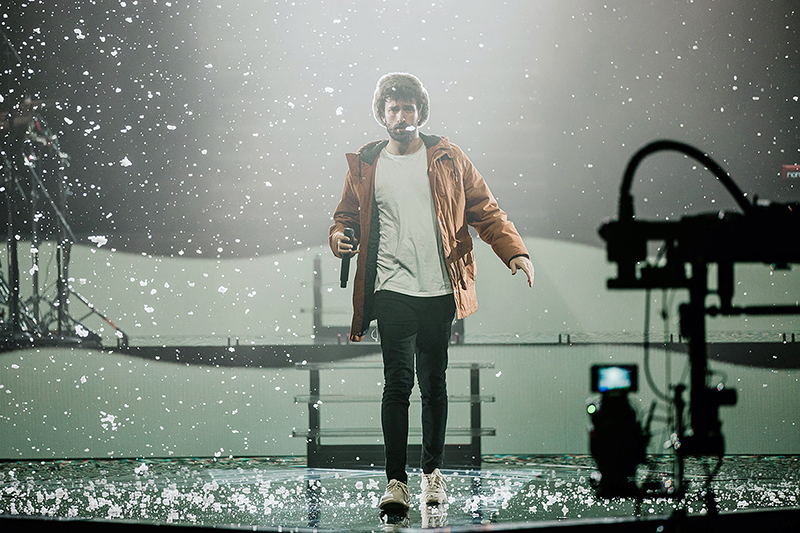
This first use of the epiQ console in a concert touring environment, especially for wire work, demonstrated its ability to bring together the control of all live event operations in a single unit.
Tait’s Marc Thomas served as the epiQ programmer and operator for the event. “Usually I have to sit down for hours and plan each piece,” said Schellenger. “This was very different. I gave them the visual and the audio track, and a few minutes later Marc would say, ‘You want to see it?’”
Synchronized show control clearly made many ideas come alive for the band and for Station Six, including the ability to use the studio’s entire 30,000 square-foot capacity for the show. “I had yet to see a streaming show that was the height and width of an arena show,” said Schellenger. “It makes me sad to see a 10-foot video wall shoved into the corner of a studio.”
For the song “Bummerland,” for example, a stagehand actually picks up Jack and carries him across the studio and through what appears to be several stage sets until they reach the main stage. Seconds later, Ryan leaves the main stage and walks to another one, where static-filled CRT-style television sets form the background for “Netflix Trip.” By the end of the song, he and the band have relocated once again, returning to the main stage for a finale of stacked, flashing TV screens on video and a blazing display of LED lighting.
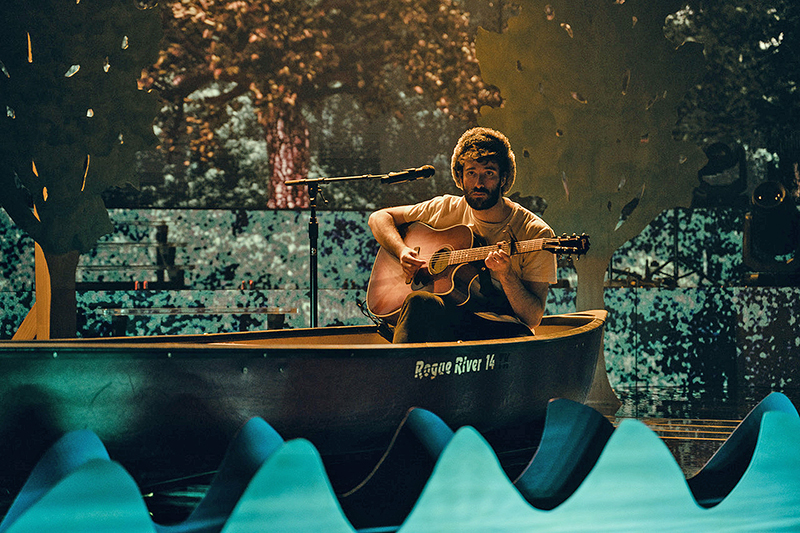
“Netflix Trip” provided lighting designer Ezra Donellen with what he calls his “Yes! moment,” the point in the show that he found most satisfying. On a single strip of red carpet, all of the band members stood single file as the camera tracked along the row of singers and musicians. Singers that disappeared after the camera passed them returned seconds later, appearing again in the front of the line. “The band came up with the concept,” said Donellen, “and I wanted to light this runway with columns of light. The negative space between the light, it was a beautiful, simple moment.”
Donellen made the most of the inventory supplied by Morris Light and Sound, filling the studio with 64 Elation Chorus Line 16 bar wash luminaires, 48 Robe MegaPointe all-in-one fixtures, 64 Robe Esprite LED automated luminaires, 30 Robe BMFL Wash luminaires, 54 Robe Spiider WashBeam luminaires and 40 GLP JDC1 strobes. “Once I really unlocked the power of the JDC1, there was no looking back,” said Donellen. “It is such a versatile fixture. It’s a wash, it’s a strobe, you can do pixel stuff with it. I love that fixture.”
The hands at the grandMA2 full-size lighting console belonged to Manuel “Manny” Conde, who served as lighting director, lighting programmer and screens programmer. “Manny is the first programmer that I worked with on a show of this caliber, and he is a complete pro,” said Donellen. “A good programmer knows how to bring the design to life. Manny’s superpower is that I have ideas in my head, and even though this was the first time I worked with him, he intuitively knew what to do.”
In one of the most fanciful interactions with the video, the screen turns into college-ruled lined paper, and Jack appears to tear out a section to reveal a pencil taller than he is. He grabs this pencil, which turns out to be a tangible prop, and begins to draw with it on the video “paper.” Soon he’s drawn a door, and when it opens — yes, of course, it opens — a pencil-sketched figure joins him in drawing the elements of a guitar. In a moment, the guitar disappears over the top of the paper, and a giant video hand appears to hand Jack an actual guitar. Jack stays upstage to accompany Adam, who usually handles the guitar responsibilities, but who now comes center to sing “Sober Up.”
Video hands that lifted Jack into the air; a grand piano rising on a scissor lift as Ryan, also rising in a cloud of fog, continues to play as he becomes perpendicular to the keyboard; and a frenetic laser show for “Weak,” one of the band’s biggest hits —all of these and more made “One Spectacular Night” live up to its name.
Working with AJR has become a labor of love, Donellen added. “I think it’s the coolest thing that they care about production, and I love how thoughtful they are about it. They love lighting, they love lasers, they want to do wires, they ask, ‘What can we do next?’ I admire them for pushing and always wanting a high level of production.”
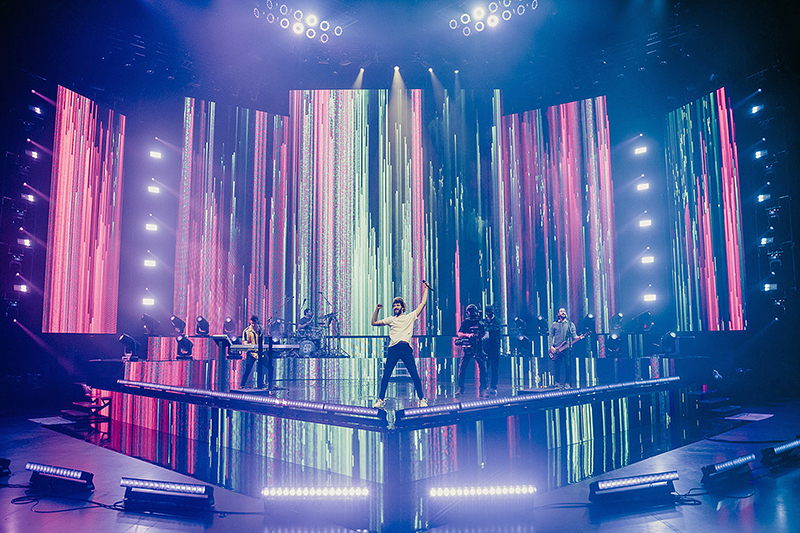
Randi Minetor is a freelance journalist and author based in upstate New York.
For more details on crew and gear, go to https://plsn.com/articles/showtime/showtime-close-up-ajrs-one-spectacular-night-at-rock-lititz/


